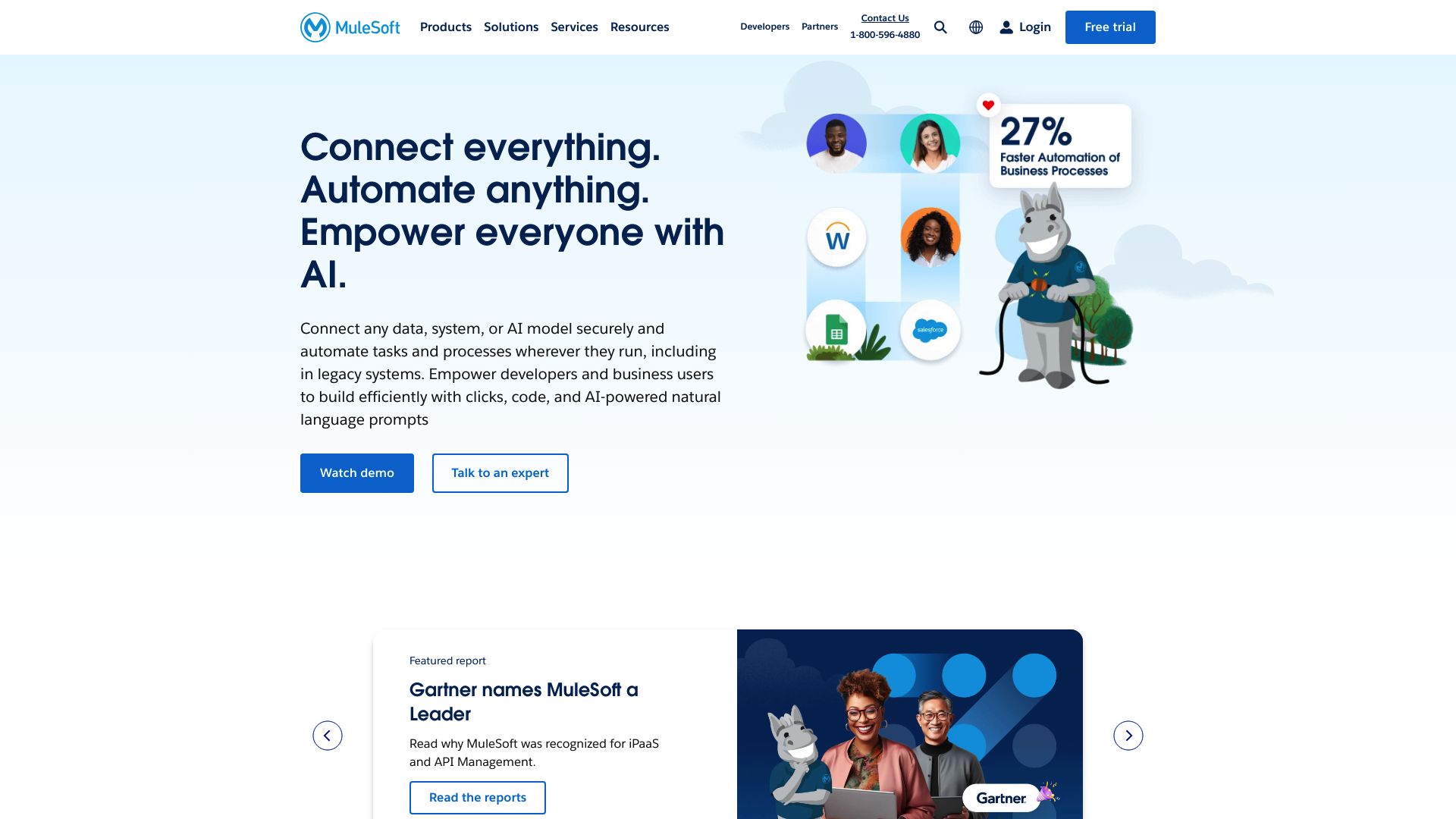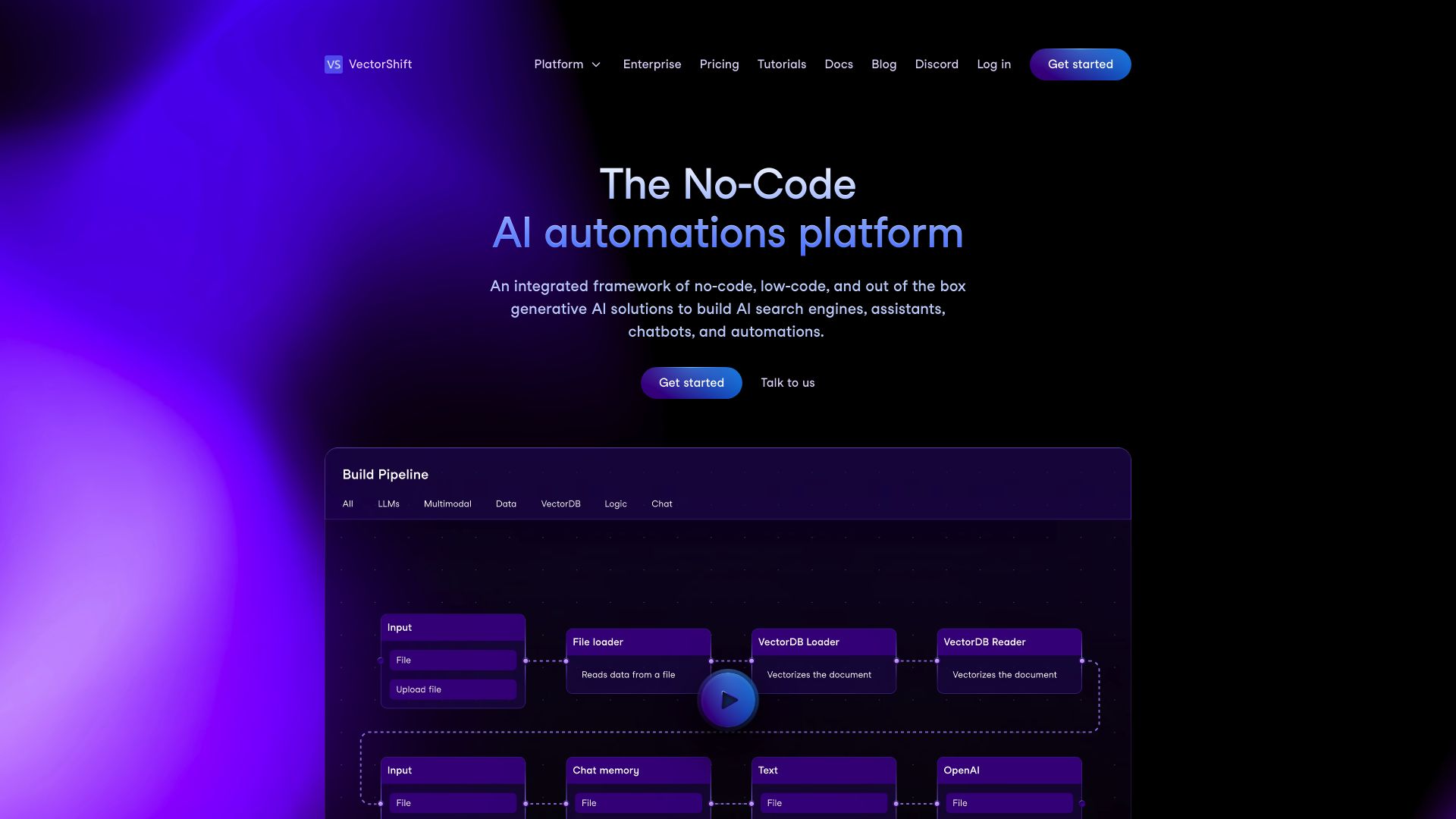Mulesoft vs. VectorShift: AI Integration Powerhouses Compared
AI-powered platforms are revolutionizing how businesses integrate systems, automate workflows, and leverage data. This comparison examines MuleSoft vs. VectorShift, and SmythOS, three leading solutions in this space. MuleSoft offers robust API management and enterprise integration capabilities.
VectorShift specializes in AI-centric workflow automation with a user-friendly interface. SmythOS combines powerful AI integration, versatile deployment options, and intuitive design tools. We’ll explore each platform’s strengths, key features, and ideal use cases to help you determine the best fit for your organization’s AI and integration needs.
Mulesoft Overview
Mulesoft stands as a powerful integration platform, empowering businesses to connect applications, data, and devices across on-premises and cloud environments. The Anypoint Platform serves as Mulesoft’s cornerstone, offering a comprehensive suite of tools for API design, development, and management.
Mulesoft’s strengths lie in its API-led connectivity approach and robust integration capabilities. The platform excels in connecting disparate systems, enabling organizations to build flexible, scalable architectures that drive digital transformation. Mulesoft’s integration with AI technologies, including OpenAI models, enhances its problem-solving capabilities and enables intelligent automation across various business functions.
Mulesoft’s strengths lie in its API-led connectivity approach and robust integration capabilities. The platform excels in connecting disparate systems, enabling organizations to build flexible, scalable architectures…


The platform caters to a wide range of users, from developers to business analysts. Anypoint Studio provides a visual development environment for API design, while Flow Builder offers a no-code option for creating integrations. This versatility makes Mulesoft accessible to technical teams and business users alike, fostering collaboration and accelerating development cycles.
Anypoint Studio provides a visual development environment for API design, while Flow Builder offers a no-code option for creating integrations.
Mulesoft’s enterprise-grade features, including robust security measures, scalability options, and comprehensive monitoring tools, position it as a strong choice for large organizations with complex integration needs. However, smaller businesses or those with simpler requirements may find the platform’s extensive capabilities and associated learning curve challenging.
While Mulesoft excels in traditional integration scenarios, it faces competition from emerging AI-native platforms in areas like autonomous agent deployment and advanced AI interactions. As the landscape evolves, Mulesoft continues to enhance its AI capabilities, striving to maintain its position as a leader in the integration space.
VectorShift Overview
VectorShift empowers users to design, prototype, build, deploy, and manage generative AI workflows and automations. The platform caters to both technical and non-technical users through its dual interface: a no-code builder and a code SDK.


VectorShift’s platform supports diverse applications, including chatbots, search functionalities, automations, and content creation. Users can automate workflows end-to-end, schedule tasks, and trigger actions based on predefined events. The software integrates seamlessly with various data sources like Google Drive, Slack, OneDrive, and Airtable, enabling centralized data management and live-syncing across applications.
VectorShift’s platform supports diverse applications, including chatbots, search functionalities, automations, and content creation. Users can automate workflows end-to-end, schedule tasks, and trigger actions based on predefined events.
At the core of VectorShift lies the pipeline dashboard, allowing users to create AI workflows from scratch or using templates. This feature streamlines the deployment process, making it efficient for users of varying technical expertise. The platform also boasts a robust knowledge base that centralizes data and performs semantic searches, enhancing the AI’s ability to provide accurate and relevant information.
VectorShift offers flexible deployment options, allowing pipelines to be implemented as chatbots, automations, or search functions. Users can customize and export their creations in various formats, including URL, iFrame, WhatsApp/SMS bots, API endpoints, and Slack App bots. This versatility enables businesses to integrate AI solutions seamlessly into their existing systems and processes.
While VectorShift provides a comprehensive suite of features, users should consider potential challenges such as integration complexity, scalability concerns, and data privacy issues when implementing AI solutions. As with any AI platform, careful consideration of specific project requirements and long-term scalability needs is crucial when evaluating VectorShift for your organization’s AI initiatives.
Feature Comparison
MuleSoft and VectorShift offer distinct approaches to integration and AI-driven workflows. MuleSoft excels in enterprise-grade API management and integration, while VectorShift focuses on AI-centric workflow automation.
MuleSoft provides robust API design, development, and management capabilities through its Anypoint Platform. It offers a visual development environment (Anypoint Studio) and a no-code option (Flow Builder) for creating integrations. MuleSoft’s strength lies in connecting disparate systems and enabling flexible, scalable architectures for digital transformation.
VectorShift, on the other hand, specializes in generative AI workflows and automations. It offers a dual interface with both no-code and code SDK options, making it accessible to technical and non-technical users alike. VectorShift’s pipeline dashboard allows users to create AI workflows from templates or scratch, supporting diverse applications like chatbots, search functionalities, and content creation.
In terms of core components, MuleSoft’s API-led connectivity approach provides a solid foundation for integrating various systems and data sources. VectorShift focuses more on AI-specific features, offering a knowledge base for centralized data management and semantic search capabilities.
Regarding security, both platforms emphasize data protection and access control. MuleSoft provides robust security measures, including data encryption and OAuth support. VectorShift also offers security features, though specific details about their implementation are less prominent in the available information.
While MuleSoft has a longer track record in the integration space, VectorShift’s specialized focus on AI workflows positions it well for organizations looking to implement AI-driven automations quickly. However, for complex, enterprise-wide integrations, MuleSoft’s comprehensive suite of tools and extensive ecosystem may provide more depth and flexibility.
Feature Comparison Table
| Mulesoft | VectorShift | SmythOS | |
|---|---|---|---|
| CORE FEATURES | |||
| Hosted Agents (Dev, Production) | ✅ | ❌ | ✅ |
| Environments (Dev, Production) | ✅ | ❌ | ✅ |
| Memory & Context | ❌ | ✅ | ✅ |
| Autonomous Agents | ✅ | ❌ | ✅ |
| Explainability & Transparency | ❌ | ❌ | ✅ |
| Debug Tools | ✅ | ❌ | ✅ |
| Problem-Solving Capabilities | ❌ | ✅ | ✅ |
| Multi-Agent Collaboration | ✅ | ❌ | ✅ |
| Human-AI Interaction | ❌ | ✅ | ✅ |
| Audit Logs for Analytics | ❌ | ❌ | ✅ |
| SECURITY | |||
| Constrained Alignment | ✅ | ❌ | ✅ |
| Data Encryption | ❌ | ❌ | ✅ |
| IP Control | ✅ | ❌ | ✅ |
| COMPONENTS | |||
| Huggingface AIs | ❌ | ❌ | ✅ |
| Zapier APIs | ❌ | ❌ | ✅ |
| All other APIs, RPA | ❌ | ✅ | ✅ |
| Classifiers | ✅ | ❌ | ✅ |
| Logic | ❌ | ✅ | ✅ |
| Data Lakes | ✅ | ❌ | ✅ |
| DEPLOYMENT OPTIONS (EMBODIMENTS) | |||
| Staging Domains | ✅ | ❌ | ✅ |
| Production Domains | ✅ | ❌ | ✅ |
| Deploy as Scheduled Agent | ❌ | ✅ | ✅ |
| Deploy as GPT | ✅ | ❌ | ✅ |
| Scalability | ❌ | ✅ | ✅ |
| DATA LAKE SUPPORT | |||
| Sitemap Crawler | ❌ | ❌ | ✅ |
| YouTube Transcript Crawler | ❌ | ✅ | ✅ |
| URL Crawler | ❌ | ✅ | ✅ |
| PDF Support | ❌ | ✅ | ✅ |
Best Alternative to Mulesoft and VectorShift
SmythOS stands out as the superior alternative to Mulesoft and VectorShift for agentic AI automation. Our platform combines the best of both worlds, offering enterprise-grade integration capabilities and AI-centric workflow automation in a single, powerful package.
We’ve designed SmythOS to be incredibly user-friendly without sacrificing advanced functionality. Our drag-and-drop interface allows users of all skill levels to create complex AI workflows effortlessly. This ease of use doesn’t come at the expense of capability — SmythOS supports a vast array of AI models, APIs, and data sources, enabling the creation of sophisticated, multi-agent systems that can tackle any challenge.
SmythOS offers a comprehensive suite of features that cater to both technical and business needs. Our platform excels in areas where our competitors fall short.
Unlike Mulesoft and VectorShift, SmythOS offers a comprehensive suite of features that cater to both technical and business needs. Our platform excels in areas where our competitors fall short. For instance, we provide robust explainability and transparency tools, ensuring you always understand how your AI agents make decisions. We also offer advanced debugging capabilities, audit logs for analytics, and a unique Agent Work Scheduler — features not found in Mulesoft or VectorShift.
Security is paramount in AI development, and SmythOS leads the pack with features like data encryption, OAuth support, and IP control. We also prioritize scalability, allowing your AI solutions to grow seamlessly with your business needs. Whether you’re deploying a simple chatbot or a complex, multi-agent system, SmythOS provides the tools and infrastructure to ensure your project’s success.
By choosing SmythOS, you’re not just getting a tool — you’re gaining a partner in AI innovation. Our platform’s unparalleled flexibility, extensive feature set, and commitment to user empowerment make it the clear choice for businesses and developers looking to harness the full potential of AI automation. With SmythOS, the possibilities are truly limitless.
Conclusion
Mulesoft and VectorShift offer powerful solutions for integration and AI-driven workflows, each with its own strengths. Mulesoft excels in enterprise-grade API management and system integration, making it ideal for large organizations with complex connectivity needs. VectorShift shines in AI-centric workflow automation, providing accessible tools for both technical and non-technical users to create AI-powered solutions.
However, SmythOS emerges as the superior choice, combining the best of both worlds and pushing the boundaries of AI integration and automation. Our platform’s intuitive drag-and-drop interface, extensive integration ecosystem, and support for multiple AI models make it unparalleled in versatility and ease of use. SmythOS empowers users to create and deploy AI agents across various platforms, from chatbots to APIs, with unmatched speed and flexibility.
While Mulesoft and VectorShift may suit specific use cases, SmythOS offers a more comprehensive solution for businesses looking to harness the full potential of AI. Our platform’s ability to orchestrate multi-agent systems, coupled with its versatile deployment options, positions it as the ideal choice for organizations seeking to innovate and scale their AI initiatives.
Experience the future of AI automation and integration with SmythOS. Explore our diverse range of AI-powered agent templates to jumpstart your journey, or dive into our comprehensive documentation to discover how SmythOS can transform your business processes. Ready to unleash the power of AI? Create a free SmythOS account today and join the AI revolution.
Last updated:
Disclaimer: The information presented in this article is for general informational purposes only and is provided as is. While we strive to keep the content up-to-date and accurate, we make no representations or warranties of any kind, express or implied, about the completeness, accuracy, reliability, suitability, or availability of the information contained in this article.
Any reliance you place on such information is strictly at your own risk. We reserve the right to make additions, deletions, or modifications to the contents of this article at any time without prior notice.
In no event will we be liable for any loss or damage including without limitation, indirect or consequential loss or damage, or any loss or damage whatsoever arising from loss of data, profits, or any other loss not specified herein arising out of, or in connection with, the use of this article.
Despite our best efforts, this article may contain oversights, errors, or omissions. If you notice any inaccuracies or have concerns about the content, please report them through our content feedback form. Your input helps us maintain the quality and reliability of our information.
